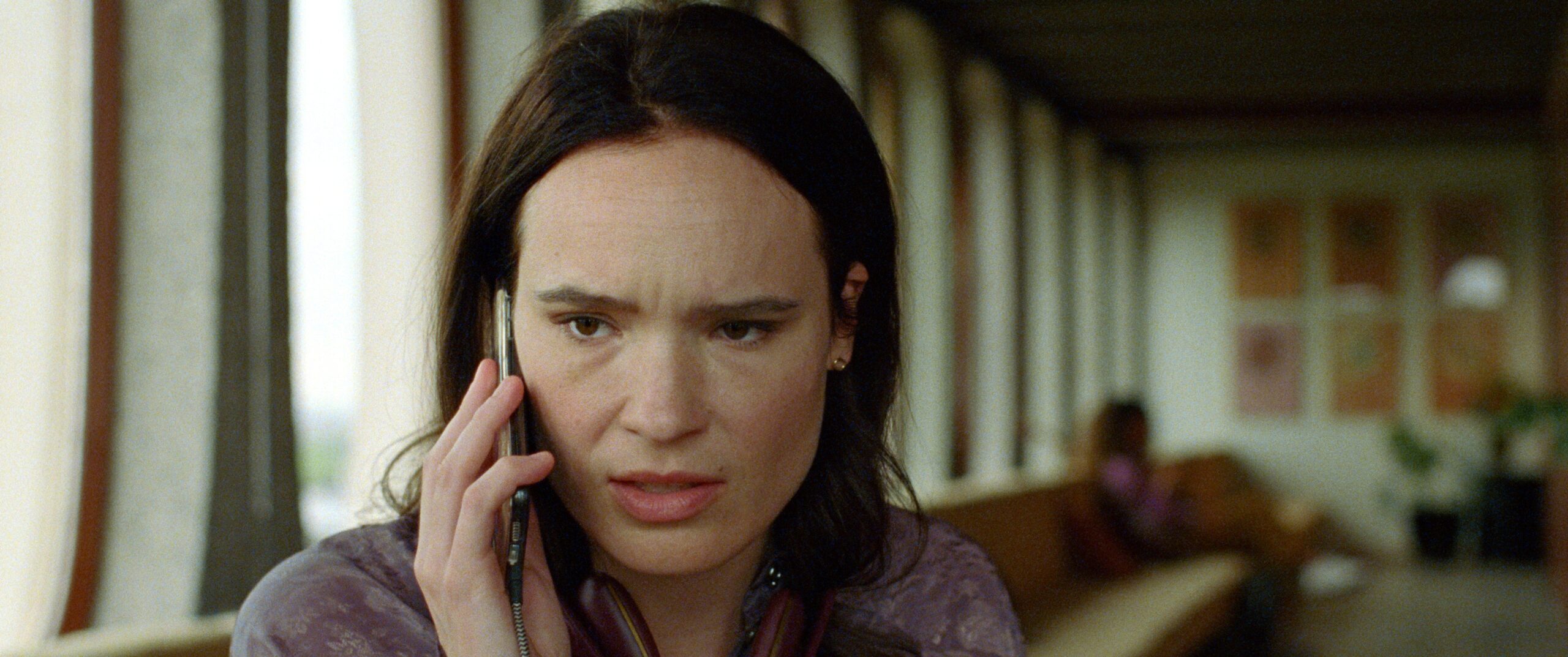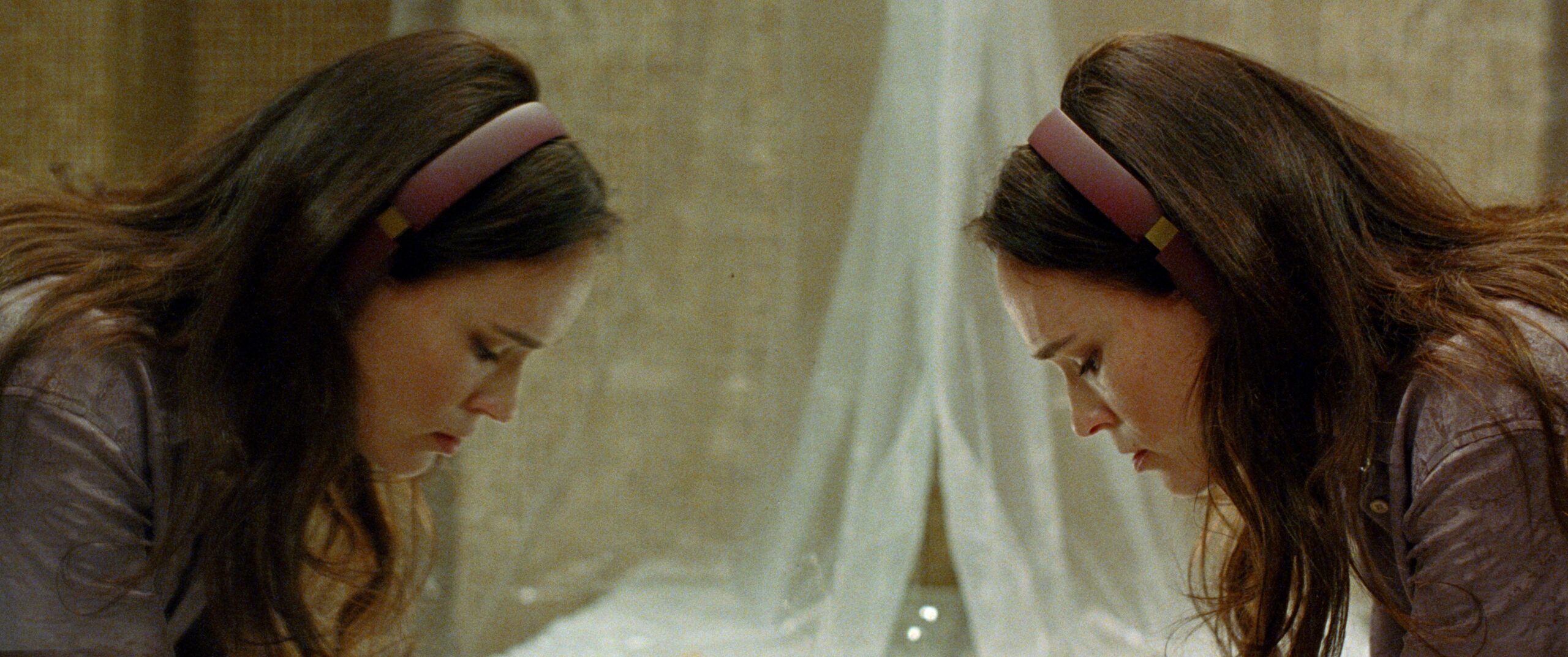Have you ever had to prove you were a human?
In Victoria Warmerdam’s short film I’M NOT A ROBOT (2023), humanness is verified by the successful clearance of a CAPTCHA. With the goal to correctly identify an object like a car within a picture, these tests are meant to deter bots. As AI continues to develop, a possible future where failing the test could mean you’re a robot is outlined in this dark comedic-drama.
Lara is a music producer listening to a choral rendition of Radiohead’s “Creep” during the opening credits. Her daily life at work is disrupted by an update alert that requires the completion of a CAPTCHA. After numerous frustrated attempts to pass the test, she calls customer service for help. A cutaway moment from taking a more detailed robot identification test has Lara, curious, asking her coworker if she comes across as cold. But when the customer service representative tentatively broaches the uncertainty of her humanness, Lara begins to spiral.
The film is visually filled with a juxtaposition of cold concrete and blue light with warm tones and greenery. There’s an almost invisible divide within the blend of natural and man-made that reflects the possible fake amidst the real. The 2.35:1 aspect ratio allows for a wider screen that enhances the many slow zoom-ins and long takes utilized throughout the film. Lara’s reactions and movements are tracked in a dizzying manner that doesn’t afford the viewer relief. When she is displaced and disoriented, so are we. The ambience and conversation chatter overwhelm her as she tries to find a place of peace and quiet from the constant noise.
A phone call to her wealthy partner Daniël from the company bathroom stall does not provide reassurance. Doubt creeps in as Lara misunderstands conversation. She hears Daniël say he’s with toys, instead of his friends, and thinks a handyman wants her to fix a cabinet door. There seems to be a disconnect between her and them.
Perhaps, Lara is a robot.

The desire for workplace inclusivity is highlighted by one of Lara’s coworkers during an interview. Two details in particular add to the world-building: idle conversation over diversity hires and acknowledging the whiteness in the office, which serves as self-awareness for the film’s cast. Rarely is there media depiction that calls a man the diversity hire.
After abruptly, and obviously, hanging up, Daniël unexpectedly arrives at Lara’s workplace. He is clearly there to confirm her fears, and uncomfortable because of it. Pam, a woman Lara does not know, simplifies human and robot identities to labels as she positions herself and Daniël opposite from Lara in both the conversation and seating arrangement. It is Pam who is relied on to deliver the blunt truth: Lara is a robot. But not only is she a robot instead of human, she was “collected” by Daniël.
The film demonstrates how quickly a woman can lose her autonomy. Despite only having two on-screen male characters and the music company’s hinted preference for female workers creating a predominantly female space, it is with astounding ease that Lara’s world is turned upside down from the whims of a man.
Daniël has concern only for his own pain, not Lara’s. His decision to buy her was based on a previous romantic experience, when the human woman he loved died. He doesn’t want to mourn Lara as he did Olivia. So he decided her time to die will be the same as his. Pam and Daniël claim a robot cannot choose their own death, and as her owner, he made the choice for her.
The recognition of her true reality throws Lara’s surety in self off-balance. Her identity as a human is no more. She may be autonomous, but the true separation between her and Daniël is the freedom of choice. Despite his assurances on her autonomy and the realness of their relationship, Daniël does not view Lara as human. Just as her life is not her own, their relationship also cannot be real. Any feelings of love are too deeply interconnected with the ownership and control he holds over her.
One blip of relief from the tension occurs as Lara shouts at Daniël that just because she’s a feminist doesn’t mean he is. Lara’s irritation, even as she’s patronized for her justifiable reactions, is satisfying to see expressed. On the rooftop of the company building, she acts to reclaim herself and separate entirely from him. Lara finally accepts her situation and chooses to take one final robot identification test.
As the credits roll, the opening song “Creep” returns. Humans live because they die, the film seems to say. There’s meaning to the life lived that can’t be earned without death at the end.
If she can’t die until Daniël does, what control does Lara have over her own life?


Carley Matsumura is a Creative Media student pursuing a BA in Communications and New Media Technologies and a Certificate in Music at the University of Hawai’i–West O’ahu. Her interest in storytelling originates from the community aspect of sharing a connection with others. She enjoys the way themes explored within film can be interpreted through symbolism. Carley looks forward to the possibilities of a career involving storytelling after graduation.
The HIFF ONLINE CREATIVES & CRITICS IMMERSIVE (HOCCI) program supports sustainable film criticism in Hawai’i through mentorship and paid career opportunities for Hawai’i-based AANHPI critics. The mission of HOCCI is to broaden diversity in film criticism across the Pacific and use influencer branding strategies to spark career opportunities. The 2024 HOCCI is supported by Critical Minded, a grant-making and learning initiative that supports cultural critics of color in the United States.



